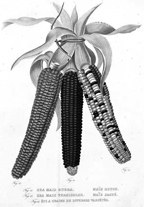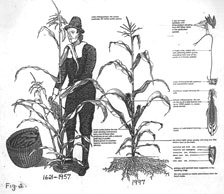 |
Reflections on
|
 |
The earliest authenticated documentation of what, by almost any community standard, would be considered pornography, was perhaps that of the ‘Little Books’ (1623-27), uncovered in 1919 by Professor Jason Lewellen, and believed to have been among the belongings of the so-called ‘Plymouth Pimps’ – one of the first of numerous groups of seafaring men who dealt in guns, rum, drugs, slaves, and indentured prostitution, plying their trade along the Bay Colony coast.
 |
The work referred to – the ‘Little Books’, as they were called – was comprised of line-drawings, printed from carved wooden blocks, on rough rag paper, in a 4 by 5 inch format. The ‘pages’ were perforated – probably by an Addison double-hole thumb-punch – and held together in book form with coarse hemp-twine.
Aside from the Settler, the characters figuring most prominently in the work, were the Indian and the turkey. A typical ‘Little Book’ might begin with the representation of an Early Settler in a corn-field, completing preparation of a ‘corn-hole’, his member exposed and in a state of erection. As he is about to enter the ‘corn-hole’, his attention is attracted by something nearby – presumably a sound or movement – and he then sees, in an adjacent row, an Indian and a turkey, writhing exaggeratedly in fervent coitus.
 |
The Indian is at first apprehensive at being discovered, but is quickly reassured by the Settler, who makes it known that he would like to join in the sexual activity, with eager gestures to this effect.(1)
After a brief period of sexual congress between the two men and the turkey (which would generally include both fellatio and anal-intercourse, or ‘corn-holing’ as it was known), the Settler would address the Indian, in one of the book’s few captions: “You get squaw”, whereupon they would be joined by an attractive Indian ‘princess’ type, attired in buckskin and tassels, and voluptuously endowed. The two men and the turkey would then ravish the Indian maiden, in various positions and combinations.
 |
While primarily erotic, the ‘Little Books’ were not without an occasional touch of humor, as, for example, when the turkey would be shown as having collapsed in exhaustion, leaving the two men and the girl to the more conventional techniques of love-making. It would be difficult, however, to overstress the role of the turkey in this early literature, though the reference was often oblique.
It was widely acknowledged, for example, that the Settlers had frequent intercourse with the turkey, yet in the literature (other than the ‘Little Books’) and in the humor which has come down to us on the subject, it is usually the Indian who is sexually linked to the bird.
And, according to Holbrook (2), an oft employed cajolery at the Settler’s table, when turkey was being served, was on the order of: “Why I bet this here bird is jest a’brimmin’ with that good ole redskin-jissem!”
The ‘Little Books’ abound with reference to, and portrayals of, another practice known to have been fairly common among the Settlers called ‘Gobbling the Gobbler’, in which fellatio – of both an anal and genital nature – would be performed on the birds, by Settlers and Indians, cavorting in lively fashion the while.
Yet another depiction of high incidence in the ‘Little Books’, and, by present standards, perhaps the most unusual, was the act of combined intercourse and anal-head-congress between Puritans and turkey, a practice known as ‘Gobble Jamming’; it was performed in both standing and prone positions, and required the bird to be situated upside down, between the legs of the Settler, its head towards the rear.
 |
The Settler would first enter the bird in the ‘normal’ manner (i.e., into the vent, or genitalia) and then, upon approaching climax, would reach behind him, seize the turkey’s head (which had been heavily lubricated, with bear or goose grease) and forcibly thrust it, screeching wildly, up his anus. In his Memoirs, H.A. Walton, at that time Lt. Governor of Rhode Island (1743), described the ‘Gobble Jamming’ experience as being “quite extraordinary in its sheer sensory impact”, and it should be noted that this remarkable practice continues today, among certain Americana-cult groups such as the Daughters of the American Revolution and their male counterpart, the Sons of the American Revolution – though in a somewhat more covert fashion than it did with their forebearers, to be sure.
(1) Early examples of ‘Little Books’ rarely contained any dialogue, for the reason that illiteracy was almost universal among the population.
(2) Holbrook, Albert J., The History of American Literature. New York: MacMillan Co., 1952, pps. 437-38.
